Highlights From the International Swimming Hall of Fame Induction Ceremony
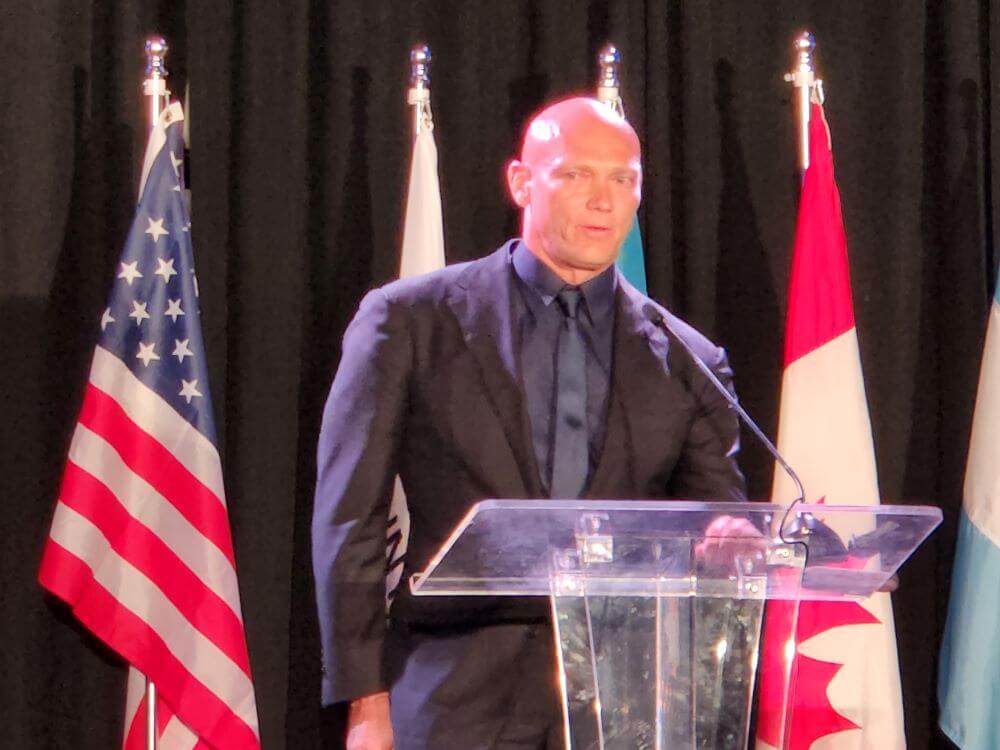
Highlights From the International Swimming Hall of Fame Induction Ceremony
Throughout the International Swimming Hall of Fame induction ceremony over the weekend, members of the Class of 2022 shared numerous stories during their enshrinement speeches. It was truly a celebratory event in Fort Lauderdale, the 57th of its kind. Here are a few highlights from this special evening.
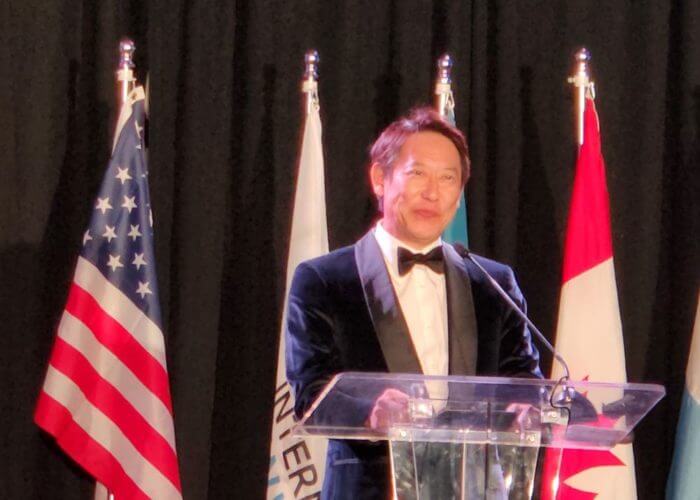
Photo Courtesy: John Lohn
• The 1988 Olympic champion in the 100-meter backstroke, Japan’s Daichi Suzuki was known for his underwater prowess, and that theme was a big part of Suzuki’s induction. During his speech, Suzuki acknowledged rival David Berkoff – who revolutionized underwater kicking – for laying groundwork and motivating him to elevate his performances.
Adding to the underwater theme was the fact that Suzuki was presented with his Hall of Fame sash and award by Jesse Vassallo, the 1980 and 1984 United States Olympian. In the late 1970s, it was Vassallo who first introduced the benefits of underwater power, which play a critical role in the sport today.
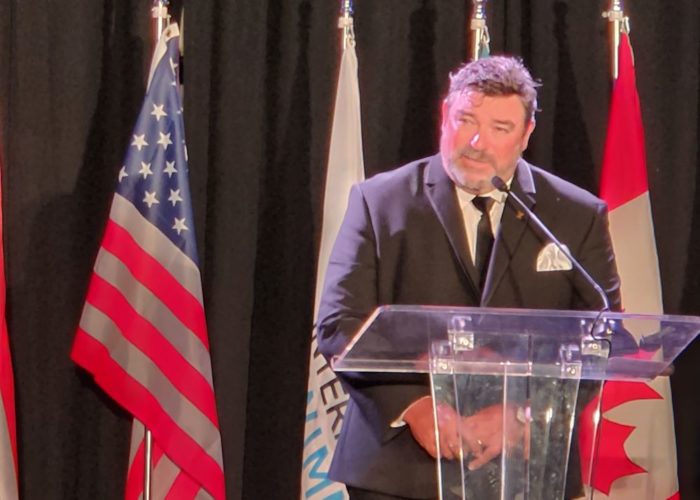
Photo Courtesy: John Lohn
• At the 1984 Olympics in Los Angeles, West Germany’s Michael Gross was the heavy favorite to claim gold in the 200 butterfly. Instead, Australian teenager Jon Sieben, on the strength of a phenomenal last lap, reeled in the field and registered one of the great upsets in the sport with a world-record performance of 1:57.04.
Because the trip from his homeland to Fort Lauderdale is lengthy, Sieben indicated there was an initial uncertainty as to whether he would attend the induction ceremony. But once he heard that fellow 200 butterfly star Craig Beardsley was being enshrined, too, the decision to make the long trip was a no-brainer.
Sieben elicited a number of laughs from the audience, especially when he spoke of downing several beers – in grand Aussie fashion – with anyone who wanted to join the post-induction gathering at the hotel bar.
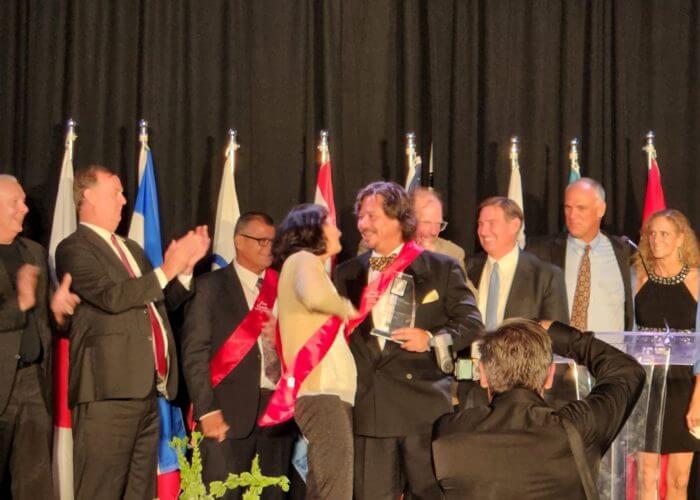
Photo Courtesy: John Lohn
• Craig Beardsley undoubtedly had the biggest support family in attendance, as he was joined by a collection of his 1980 Olympic teammates and fellow University of Florida Gators. Due to the boycott of the 1980 Olympics by the United States, Beardsley never got the chance to race at the Games, and the two-time world-record setter made a plea for politics to never again short-circuit athletic dreams in similar fashion.
As Beardsley walked onto the stage to give his speech, he was met with a standing ovation from his friends. A longtime fundraiser for Swim Across America, Beardsley spoke about compassion and kindness changing the world, and how we all can make a difference. He then invited his 1980 Olympic teammates to the stage as he received his awards.
• Australian great Michael Klim had the chance to cherish his induction with his parents (Wojtek and Ewa) and girlfriend, Michelle Owen, by his side. Klim was recognized for an illustrious career that featured six Olympic medals and 54 overall medals from international competition. At the 1998 World Championships in Perth, Klim walked away with seven medals.
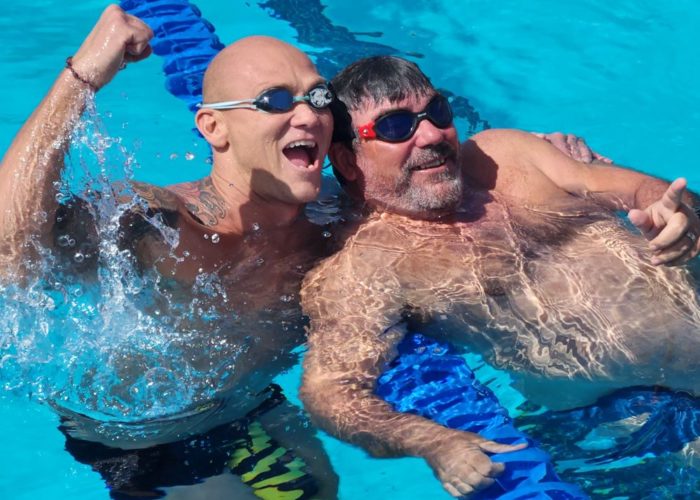
Photo Courtesy: John Lohn
Growing up, Klim moved around the world due to his father’s work. During his speech, the freestyle and butterfly star noted the importance of swimming in providing stability and consistency to his life. Although he may have had an adjustment period with each move, the pool acted as a security blanket for Klim, who could immediately connect with the water.
Several months ago, Klim revealed he is battling Inflammatory Demyelinating Polyneuropathy (CIDP), a neurological disorder that progressively weakens function of the arms and legs. The Aussie first experienced symptoms, including numbness in his feet, a few years ago. In the face of his medical condition, Klim looked great at the ceremony and even logged some laps at the Hall of Fame Aquatics Center prior to the evening festivities.
• Australian diver Matthew Mitcham, who secured Olympic gold in the 10-meter platform event at the 2008 Games in Beijing, took a moment to pay tribute to his idol, Greg Louganis. Mitcham noted that Louganis was first an idol based on his diving excellence, but soon became one of his heroes in life. It was fitting, then, that Louganis presented Mitcham with his honors.
• Inducted into the Hall of Fame as an Honor Contributor for her years of service as an official with USA Swimming and FINA, Carol Zaleski shared a story of getting involved in the sport. When her kids were competing, she recalled seeing other parents on deck as timers, and thought it was a great way to get closer to the action and give back. Years later, Zaleski’s time in the sport is defined by giving back – on the national and international levels.
• With the induction of Australian coach Ursula Carlile, she joined her husband, Forbes Carlile, as Hall of Fame honorees. The Carliles are the first husband-wife coaching combination to be inducted into the Hall, recognition that was earned for years of guiding premier Aussie swimmers, including Shane Gould, and operating the Carlile Swim School. Carlile could not attend the ceremony, but she recorded an acceptance video which was played for audience.
• Water polo star Mirko Vicevic, who represented Yugoslavia and Montenegro on the international stage, was the first honoree of the evening and had the chance to enjoy the night with some of his coaches and former teammates. Vicevic was a gold medalist in Olympic and World Championships competition and expressed appreciation for the individuals who enabled him to reach the pinnacle of his sport.
• Feted as an Honor Contributor, Peter Hurzeler of Swiss Timing has had a major impact on the sport in regards timing, starting-block technology and backstroke ledges. During his speech, Hurzeler emphasized the importance of listening to athletes and their suggestions to make the sport better.




congratulations to all who were indicted int tho Swimming Hall of Fame.
To supplement what is said here about the underwater technique, I excerpt this from my History of Princeton Swimming and Diving, accessible freely online:
Special mention needs to be made of Hughes’s accomplishments as a backstroker. Along with Harvard’s David Berkoff, Hughes helped develop and popularize the revolutionary underwater start whereby the swimmer would try to go almost the entire first lap completely submerged, using only the reverse dolphin kick for propulsive power. Hughes explained how he got involved in this innovation in an email of November 8, 2015:
I originally got the idea from [Princeton backstroker] C. R. Orth ’85. As a high school senior in 1982, I watched Orth go half the length of the pool
underwater on his start. Then I started going up to 2/3 length of the pool off my standup backstroke start. The following year I went to Stanford where I struggled. When I told [Coach] Skip Kenney I was transferring to Princeton, he told me I was giving up and would never do anything in swimming. He told me swimming on the east coast was impossible. Clearly Berkoff and I saw things differently. By my junior year at Princeton I saw Berkoff going farther underwater on the start, and I tried to go farther. At NCAAs in 1986, I got fifth and Berkoff got third, and he and I were going most of the length underwater. He would pop up and do one stroke, while I did three or four.
The innovation drew national attention when the New York Times wrote a story about Berkoff, Hughes, and Stanford swimmer Jay Mortenson all doing the underwater start at the 1987 NCAAs: http://www.nytimes.com/1987/04/04/sports/players-taking-a- cue-from-flipper.html. That race can be seen here: http://bit.ly/27W3CpD. The battle between Berkoff and Hughes in that same event in the Easterns earlier that year, which Hughes won, may be viewed here: http://bit.ly/22rvQVk. The rule was changed by FINA after the 1988 Olympics when Japan’s Daichi Suzuki edged out Berkoff by .13 to win the gold medal in the 100 back, a race that is shown in this video: http://bit.ly/ 1XWPjwM.
As a footnote to this story, credit needs to go to Jesse Vassallo as evidently the first swimmer to have the idea for this technique of underwater backstroke. The Times article mentions Vassallo, but dates the invention to 1978 when Vassallo was at Mission Viejo. Charlotte Tiedemann (Petersen) ’82, however, claims that it was earlier, after Vassallo had moved from Puerto Rico to Florida in the mid-1970s, that he began this experiment: “I saw him doing it in 1975 and 1976 when I was in high school in Florida. I ended up having to swim a 50 back on a high school relay—my worst stroke by a mile but there was no one else to do it—and employed it myself. I managed to split a 27.9, which was substantially better than I could have imagined. I am sure I wasn’t underwater for nearly as long as others, but it felt like forever!”